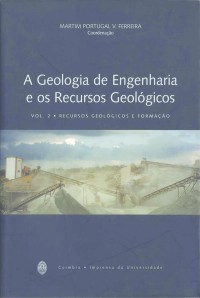Please use this identifier to cite or link to this item:
https://hdl.handle.net/10316.2/39230| Title: | Estudo geológico da pedreira da Curviã n°2 (Joane-N.N. de Famalicão): características da fracturação | Other Titles: | Geological study of the Curviã n°2 (Joane-V.N. de Famalicão): fracture pattern | Authors: | Ramos, J. M. Farinha Moura, A. Casal Moreira, A. Oliveira, A. |
Keywords: | granite massif;joint-systems pattern;quarry for aggregates production;maciço granítico;padrão de fracturação;pedreira de inertes | Issue Date: | 2003 | Publisher: | Imprensa da Universidade de Coimbra | Journal: | http://hdl.handle.net/10316.2/2760 | Abstract: | The authors have undertaken the geological study of the Curviã n° 2 quarry,
in order to make its geologic and structural characterization. In this quarry, a medium
grained monzonitic granite is exploited for the production of ballast, some other
types of aggregates and granitic sands. Analysing the fracture systems observed,
they found that, even subordinated to the main regional systems affecting the Minho
area, the pattern of these systems on the Curviã quarry is not homogeneous all
over its sectors. Thus, in the eastern flank of the quarry, a predominance of the
system Ν60Έ to Ν70Έ is clearly observed and, towards west, the relevance of
the system N40°W to N50°W, less represented in the eastern zone, increases
gradually. The N-S to Ν 2 0Έ system, closely related with an important shear
accident with this orientation, takes some evidence in the central part of the quarry.
They concluded that this variation is the result of the overlapped effects of different
phases of fragile deformation, well expressed in the regional fracture pattern, and
of the local influence of shear fractures. Os autores procederam ao levantamento geológico da pedreira da Curviã n° 2, tendo em vista a sua caracterização geológica e estrutural. Nesta pedreira, é explorado, para produção de balastros, vários tipos de britas e areias graníticas, um granito monzonítico de granulado médio, com leve tendência porfiróide, predominantemente biotítico. Ao analisarem a fracturação observada, constataram que, embora subordinada à fracturação regional que afectou toda aquela área minhota, o padrão de fracturação da pedreira da Curviã não é homogéneo em todos os seus sectores. Assim, no flanco leste da pedreira, observa-se um predomínio claro do sistema Ν60Έ a Ν70Έ e, progredindo para oeste do maciço, aumenta de relevância o sistema N40°W a N50°W, de pouca expressão na zona leste. O sistema N-S a Ν20Έ, em relação directa com importante cisalhamento que tem esta direcção, toma alguma evidência na parte central da pedreira. Concluíram que essa variação é o resultado da sobreposição dos efeitos de diferentes fases de deformação frágil, bem expressas na fracturação regional, e da acção local de fracturas de cisalhamento. |
URI: | https://hdl.handle.net/10316.2/39230 | ISBN: | 972-8704-15-1 978-989-26-0322-3 (PDF) |
DOI: | 10.14195/978-989-26-0322-3_23 | Rights: | open access |
| Appears in Collections: | A geologia de engenharia e os recursos geológicos. Vol. 2: Recursos geológicos e formação |
Files in This Item:
| File | Description | Size | Format | |
|---|---|---|---|---|
| estudo_geologico_da_pedreira_da_curvia.pdf | 8.4 MB | Adobe PDF |  |
Items in DSpace are protected by copyright, with all rights reserved, unless otherwise indicated.
